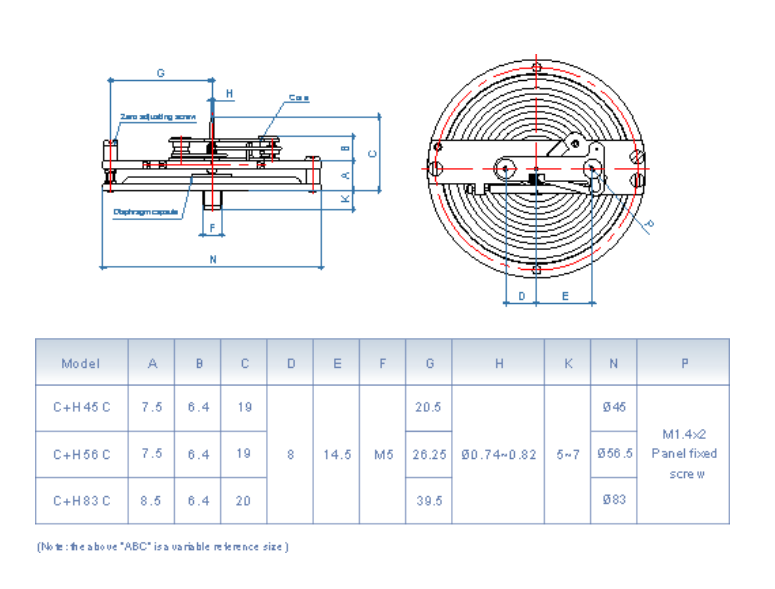
Juil . 20, 2024 01:20 Back to list
Popular Inline Differential Pressure Gauges for Accurate Measurement and Monitoring in Various Applications
Understanding Differential Pressure Gauges A Focus on In-line Applications
Differential pressure gauges are essential instruments widely used in various industries to monitor pressure differences between two points. These gauges play a critical role, especially in processes involving fluids, gases, and even slurries. In-line differential pressure gauges are specifically designed to be installed directly into the pipeline, enabling real-time monitoring of pressure changes that can indicate flow conditions or filter status. This article delves into the importance, working mechanism, advantages, and applications of in-line differential pressure gauges.
The Importance of Differential Pressure Gauges
Differential pressure measurements are pivotal for maintaining operational efficiency, safety, and performance of systems in industries such as petrochemical, pharmaceutical, food and beverage, and HVAC (heating, ventilation, and air conditioning). By measuring the pressure drop across filters, heat exchangers, and flow meters, operators can ascertain when maintenance is needed or when equipment performance is declining. Poorly maintained systems can lead to increased energy costs, equipment failure, and safety hazards.
How In-line Differential Pressure Gauges Work
An in-line differential pressure gauge typically consists of two pressure ports connected to either side of the device being monitored. These ports measure the pressure at two points—usually upstream and downstream of a filter or other equipment. The gauge calculates the difference between these pressures and displays it, allowing operators to assess the system's condition quickly.
The construction of these gauges often includes a diaphragm or bellows that responds to pressure changes. As the pressure difference occurs, the diaphragm flexes, translating the mechanical movement into a readable measurement on the gauge dial or digital display. Many modern gauges feature electronic components that improve accuracy and allow for remote monitoring, providing real-time data to operators.
famous differential pressure gauge in line

Advantages of In-line Differential Pressure Gauges
One of the primary advantages of in-line differential pressure gauges is their ability to provide immediate feedback on the health of a system. By installing these gauges directly in the pipeline, operators gain insights into critical conditions without needing manual intervention. Moreover, in-line gauges are often less prone to external environmental influences, which can affect measurement accuracy.
These gauges can also contribute significantly to operational efficiency. For instance, by monitoring differential pressure across filters, operators can identify when a filter is becoming clogged, allowing for timely maintenance. This proactive approach prevents unplanned downtime and expensive repairs resulting from equipment damage.
Applications of In-line Differential Pressure Gauges
The applications of in-line differential pressure gauges are extensive. In the oil and gas industry, they are used to monitor flow rates in pipelines, ensuring that production remains optimal. In HVAC systems, these gauges track the pressure difference across air filters, alerting maintenance teams when filters require replacement. In the pharmaceutical and food industries, where cleanliness is paramount, differential pressure gauges help ensure that filtration systems are operating efficiently, preserving product integrity and safety.
In conclusion, in-line differential pressure gauges are indispensable instruments in modern industrial applications. They not only support smooth operational processes but also help maintain safety and efficiency across various systems. As technology continues to advance, the integration of digital monitoring and data analytics will likely enhance the functionality and importance of these gauges, making them even more crucial in the quest for operational excellence across industries.
-
High-Precision 5 Valve Manifold Differential Pressure Gauge Suppliers
NewsApr.29,2025
-
High-Precision Diaphragm Vacuum Pressure Gauges Manufacturers & Quotes
NewsApr.29,2025
-
Omega Differential Pressure Gauges High Accuracy & Durability
NewsApr.28,2025
-
Low Pressure Differential Pressure Gauges Precision Solutions & Quotes
NewsApr.28,2025
-
Digital Diaphragm Pressure Gaauge Precision Measurement & OEM Quotes
NewsApr.28,2025
-
Differential Pressure Gauge China Price High-Accuracy & Best Quotes
NewsApr.28,2025
